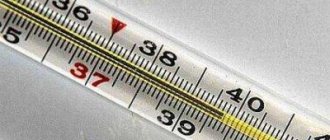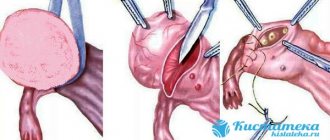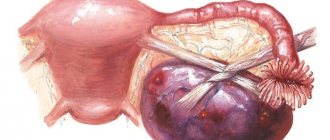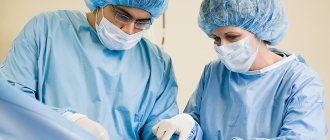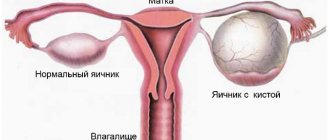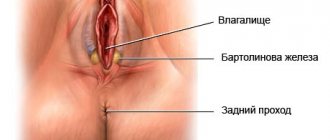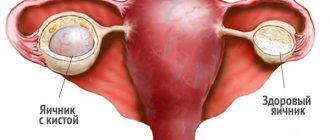How long do you stay in the hospital after laparoscopy?
In most cases, bed rest is recommended for only a few hours after surgery - after that the person can get up and walk.
To avoid negative health consequences, doctors usually advise staying in the hospital for one day in mild cases, and up to five days for more complex operations. As a rule, after this you can do recovery at home.
Postoperative period at home
As mentioned above, it is quite difficult to say exactly how long sick leave lasts after laparoscopy. It all depends on the complexity of the operation and the speed of recovery of the body. It is worth focusing on a period of 2 weeks. How the patient behaves at home also plays an important role.
Firstly, you don’t need to “stay there” for too long.
Doctors usually recommend bed rest for no longer than two to three days. You should start walking as soon as the dizziness from the anesthesia passes and the sharp pain in the area of the stitches goes away. There are no clearly defined dates, it is better to use common sense. If sharp pain occurs when moving, it is better to return to bed rest.
The incision sites themselves should be kept dry and clean. No special creams or ointments are required. In modern clinics, a special self-absorbing thread is used for sutures, which is additionally coated with surgical glue. After a couple of weeks, the glue can also be removed using soap, water and a gentle scrub. A slight discharge of ichor in incisional areas is not abnormal.
Some patients experience bruising at the incision sites. This is due to multiple damage to the tiny vessels under the skin. The hematomas will go away on their own. But the pain may not go away for several days. Along with tissues and vessels, nerves are also damaged during laparoscopic surgery. Their recovery is usually accompanied by intense pain.
Periods of incapacity for work depending on the type of operation
If we consider the question of how long sick leave lasts after laparoscopy, in general, we can note that in most cases, a certificate of incapacity for work is issued for 15 days. If the patient has undergone a major operation or recovery is fraught with difficulties, then the period may be extended for the period necessary to fully restore functionality.
How many days of sick leave are given after laparoscopy, depending on the type of intervention:
- removal of an ovarian cyst and other simple operations in the pelvic organs - 5-15 days;
- surgery on the fallopian tubes – 15-45 days;
- cholecystectomy (removal of the gallbladder) - from 14 days to 1.5 months;
- surgery on the thyroid gland, removal of hemorrhoids - 15 days;
- laparoscopy for appendicitis - 14 calendar days, followed by restriction of physical labor for another two weeks. In the acute form, which occurs in the vast majority of cases, a certificate of incapacity for work is opened for a month;
- removal of the uterus - up to 45 days.
After the “standard” sick leave period for laparoscopy of 15 days ends, the patient must undergo a medical commission - only a group of specialists can decide whether it is necessary to extend the certificate of incapacity for work or not. In extremely severe cases, a person can be treated for up to 10 months.
Methods and methods for removing ovarian cysts
In modern conditions, surgery to remove an ovarian cyst can be performed:
- in the traditional way - laparotomy, with full intracavitary surgical intervention in the abdominal cavity;
- modern low-traumatic method - laparoscopically, using endoscopic equipment.
Based on the diagnosis, the stage of development of the cyst, the condition of the surrounding tissues of the organ affected by the cyst, the following methods for removing a cyst on the ovary are distinguished:
- Cystectomy - removal without affecting the ovary and its tissues;
- Resection along with the affected tissue surrounding the formation.
- Ovariectomy and adnexectomy - complete removal of the organ affected by the formation, often along with the appendages.
The choice of removal method is determined by the doctor based on the patient’s health indicators, the type and degree of growth of the formation, the possibility of postoperative complications, which will determine the patient’s length of stay in the hospital.
We recommend you learn: Cyst on the ovary, what to do first
In what cases can sick leave be extended?
Sometimes the doctor issues an additional one to the main certificate of incapacity for work. As a rule, during laparoscopy, which is not a complex type of intervention, this happens extremely rarely.
In most cases, the decision to extend sick leave is made if:
- there are postoperative complications (damage to internal organs or blood vessels, thrombus formation, infection of sutures, malfunction of the cardiac system after anesthesia, infectious and inflammatory processes, etc.);
- there is a need for repeated surgery.
What to do to recover faster?
Lying down after laparoscopy is not recommended, as this can lead to the formation of adhesions of internal organs and other unpleasant consequences, therefore, in the hospital, medical workers try to convey to patients the need for adequate physical activity. However, doctors do not always tell you how to behave at home for a faster recovery.
In order to recover faster after laparoscopy, experts recommend:
- giving up alcohol and cigarettes for at least 3-4 weeks;
- following a gentle diet for 7 days (warm pureed food, fortified foods on the menu, excluding fried, fatty, smoked and salty foods);
- refusal of baths, saunas and solariums for 1.5 months;
- limiting any overload, including long trips, flights, etc.;
- avoiding hypothermia;
- reducing time spent in direct sunlight;
- sexual rest (for up to a month);
- taking medications recommended by a doctor;
- performing exercises to prevent the occurrence of adhesions, gradually increasing adequate physical activity (walking in the first month, therapeutic exercises - from the 5th week after surgery);
- restriction on lifting weights (no more than 3 kg until full recovery);
- women are additionally recommended to wear a support bandage in the first days after surgery, and then special underwear (up to a month).
The full recovery period after laparoscopy in most cases is one and a half months. Despite the fact that the operation rarely causes negative health consequences, patients who have undergone such an intervention need to closely monitor their health and, if there are any signs of deterioration, promptly contact their supervising doctor.
+7 , St. Petersburg +7
or via the feedback form below.
How long does sick leave last after laparoscopy?
Laparoscopy is performed for the purpose of diagnosing or treating gynecological pathologies, and is a minimally invasive procedure, after which you can begin performing your work duties within a short time. How many days of sick leave are usually given after laparoscopy and how to ensure that the recovery period does not drag on? This is what we will talk about.
Legal side of the issue
The start date of the sick leave is the day of hospitalization, and the end date is the last day of inability to perform your work. The document is drawn up by the attending physician, who decides the duration of the period of temporary disability for this patient. As an exception, a bulletin on the health status is given by the doctor of the clinic who referred the woman to the hospital to continue therapy.
It is necessary to visit the doctor on the day indicated by him for the possible closure of the sick leave. Otherwise, the specialist will make a note on the official document about the violation of the regime, which will allow the employer not to pay for the period of temporary disability in full.
The sick leave certificate is submitted to the human resources department, accounting department, or directly to the head of the organization in which the woman works. If the patient works in several places at once, then she must provide one copy of the document to each of them. It is important that each of them is designed correctly.
Sick leave period
The time during which a woman remains temporarily unable to work after surgery is determined by the doctor. Laparoscopy is considered a low-traumatic operation, so the recovery period usually does not last long. The patient does not need strict adherence to bed rest, but is only limited in physical activity. During rehabilitation, performing certain exercises is even beneficial for health.
How many days of sick leave are given after laparoscopy? There are no clear deadlines for the period of temporary disability. How quickly the body recovers is determined by the specifics of the surgical intervention and how it affected the patient’s well-being. The first time after the operation, the woman is in the hospital, but after a few days she can go home and continue to be observed by a gynecologist at her place of residence.
Length of hospital stay
The most common question that women ask about surgical treatment is: after cutting out an ovarian cyst, how long do you have to stay in the hospital? To undergo surgery to remove an ovarian cyst, a woman is admitted to the hospital one day before the scheduled date. During this period, a preparatory stage is carried out with restrictions on food and drink, with appropriate hygiene procedures and intestinal cleansing.
On the day after surgery, the patient observes strict bed rest: time is given for the body to recover from anesthesia, and painkillers may be used. Hormone therapy, vitamin supplements and immunostimulants are also prescribed. When a traditional operation with intracavitary opening and suturing of the peritoneal tissue is performed, a catheter may be needed to remove urine.
Periods of temporary disability for various operations
For what diseases is sick leave given? This document is drawn up, including for pathologies for which laparoscopy was performed, for various periods (depending on the complexity of the manipulations and the woman’s well-being). So, after surgery for an ovarian cyst, the rehabilitation period is usually no more than 10 days. But after a hysterectomy, a woman may need a sick note for up to 40 days.
Below is a table that indicates the approximate periods of temporary disability for various gynecological operations performed laparoscopically (if there are no complications).
| Type of surgery | Duration of sick leave (days) |
| Uterus removal | 20-40 |
| Ovarian cyst removal | 7-10 |
| Tubal surgery | no more than 45 |
Laparoscopy: essence and technique
Laparoscopy is an endoscopic surgical intervention in the ovarian region, which is performed without direct penetration into the abdominal cavity.
How is an ovarian cyst removed by laparoscopy? This type of surgical treatment is performed only under general anesthesia. The surgical intervention is performed through three small incisions in the abdominal cavity - the diameter of each hole usually does not exceed 0.5 - 1 cm. Next, carbon dioxide is injected into the internal abdominal cavity, which helps create the necessary surgical space. This becomes possible due to the fact that after the gas is introduced, the walls of the abdominal cavity are raised above the internal organs, providing free access to them.
Through the holes, the surgeon inserts a miniature camera and flashlight, as well as special surgical instruments. Next, all the necessary surgical procedures are performed to remove the cyst, and the holes made are sutured.
The widespread use of laparoscopy is due to its many advantages over other types of surgical treatment.
- There is no direct penetration into the abdominal cavity, which cannot be avoided during a conventional operation - accordingly, laparoscopy is an absolutely non-traumatic type of surgical intervention.
- The postoperative period for laparoscopy is much shorter than for traditional surgery.
- Both during and after laparoscopy, the woman is not accompanied by pain. Another advantage of this technique is the absence of postoperative scars and rough scars.
- With this type of cyst removal, there is no possibility of sutures coming apart or developing various inflammatory, infectious and adhesive processes.
Grounds for extending sick leave
When can I return to work after laparoscopic surgery? The standard length of sick leave is 15 days. To increase this period, the doctor must have compelling reasons. Five days are allotted for staying in a hospital setting and ten days for recovery at home. If it is necessary to extend sick leave, a special medical commission is convened. The period of temporary incapacity for work is extended in the following cases:
- occurrence of postoperative complications;
- the need for repeated surgery.
Postoperative complications include:
- damage to organs that occurred during surgery (for example, intestines), as well as blood vessels;
- allergic reactions to medications;
- bleeding;
- disturbances in the functioning of the cardiovascular system caused by anesthesia;
- suture infection;
- the appearance of blood clots.
How to make sure your sick leave doesn’t drag on
There are no uniform terms for the period of temporary disability. How quickly a woman can start working depends on her state of health after laparoscopy and the extent of the surgical intervention. If the patient wants to return to work faster, then after the operation she must adhere to the following rules:
- follow a diet for seven days;
- perform physical exercises to prevent adhesions;
- give up sports and intimacy for at least a month;
- Do not lift heavy objects (weighing more than 3 kg) for 30 days;
- wear supportive underwear for the first month;
- do not drink alcohol for at least 30 days;
- At the end of the established period, increase physical activity gradually.
Typically the rehabilitation period lasts from three to six weeks. At this time, you should not visit saunas, steam baths, take a bath, or take long trips. It is important to pay attention to proper nutrition. You should avoid fatty, spicy, fried foods, marinades, and alcoholic drinks, and give preference to foods rich in nutrients (vitamins and microelements).
How many days do you have sick leave after laparoscopy?
Laparoscopy is performed for the purpose of diagnosing or treating gynecological pathologies, and is a minimally invasive procedure, after which you can begin performing your work duties within a short time. How many days of sick leave are usually given after laparoscopy and how to ensure that the recovery period does not drag on? This is what we will talk about.
Legal side of the issue
The start date of the sick leave is the day of hospitalization, and the end date is the last day of inability to perform your work. The document is drawn up by the attending physician, who decides the duration of the period of temporary disability for this patient. As an exception, a bulletin on the health status is given by the doctor of the clinic who referred the woman to the hospital to continue therapy.
If the patient needs to travel to another area to receive medical advice or professional assistance, then the time spent on the road is also counted towards the duration of the temporary disability certificate.
It is necessary to visit the doctor on the day indicated by him for the possible closure of the sick leave. Otherwise, the specialist will make a note on the official document about the violation of the regime, which will allow the employer not to pay for the period of temporary disability in full.
The sick leave certificate is submitted to the human resources department, accounting department, or directly to the head of the organization in which the woman works. If the patient works in several places at once, then she must provide one copy of the document to each of them. It is important that each of them is designed correctly.
Sick leave period
The time during which a woman remains temporarily unable to work after surgery is determined by the doctor. Laparoscopy is considered a low-traumatic operation, so the recovery period usually does not last long. The patient does not need strict adherence to bed rest, but is only limited in physical activity. During rehabilitation, performing certain exercises is even beneficial for health.
How many days of sick leave are given after laparoscopy? There are no clear deadlines for the period of temporary disability. How quickly the body recovers is determined by the specifics of the surgical intervention and how it affected the patient’s well-being. The first time after the operation, the woman is in the hospital, but after a few days she can go home and continue to be observed by a gynecologist at her place of residence.
Periods of temporary disability for various operations
For what diseases is sick leave given? This document is drawn up, including for pathologies for which laparoscopy was performed, for various periods (depending on the complexity of the manipulations and the woman’s well-being). So, after surgery for an ovarian cyst, the rehabilitation period is usually no more than 10 days. But after a hysterectomy, a woman may need a sick note for up to 40 days.
Below is a table that indicates the approximate periods of temporary disability for various gynecological operations performed laparoscopically (if there are no complications).
| Type of surgery | Duration of sick leave (days) |
| Uterus removal | 20-40 |
| Ovarian cyst removal | 7-10 |
| Tubal surgery | no more than 45 |
Grounds for extending sick leave
When can I return to work after laparoscopic surgery? The standard length of sick leave is 15 days. To increase this period, the doctor must have compelling reasons. Five days are allotted for staying in a hospital setting and ten days for recovery at home. If it is necessary to extend sick leave, a special medical commission is convened. The period of temporary incapacity for work is extended in the following cases:
- occurrence of postoperative complications;
- the need for repeated surgery.
Postoperative complications include:
- damage to organs that occurred during surgery (for example, intestines), as well as blood vessels;
- allergic reactions to medications;
- bleeding;
- disturbances in the functioning of the cardiovascular system caused by anesthesia;
- suture infection;
- the appearance of blood clots.
If complications arise as a result of surgery, the woman may be referred to sanatorium treatment. In this case, the temporary disability certificate is extended for another 24 days. To make changes to it, the patient’s personal presence is always required.
How to make sure your sick leave doesn’t drag on
There are no uniform terms for the period of temporary disability. How quickly a woman can start working depends on her state of health after laparoscopy and the extent of the surgical intervention. If the patient wants to return to work faster, then after the operation she must adhere to the following rules:
- follow a diet for seven days;
- perform physical exercises to prevent adhesions;
- give up sports and intimacy for at least a month;
- Do not lift heavy objects (weighing more than 3 kg) for 30 days;
- wear supportive underwear for the first month;
- do not drink alcohol for at least 30 days;
- At the end of the established period, increase physical activity gradually.
Typically the rehabilitation period lasts from three to six weeks. At this time, you should not visit saunas, steam baths, take a bath, or take long trips. It is important to pay attention to proper nutrition. You should avoid fatty, spicy, fried foods, marinades, and alcoholic drinks, and give preference to foods rich in nutrients (vitamins and microelements).
A woman who has undergone laparoscopy needs to monitor her well-being. This procedure is low-traumatic and rarely leads to the development of serious complications, however, if signs indicating a deterioration in your health appear, you should consult a doctor as soon as possible.
oyaichnikah.ru
HOW IS THE RECOVERY PERIOD IN THE HOSPITAL?
Laparoscopy is a method of surgery with a low degree of trauma. Instruments are inserted into several punctures in the abdominal cavity. Special manipulators - instruments equipped with lighting and a camera - can reduce the risk of complications and speed up rehabilitation.
On the first and second days, the woman’s body experiences discomfort and even pain associated with the use of carbon dioxide, which is filled with the abdominal cavity during the operation. Gas pressure can provoke pain in the heart, liver, even in the neck. Then the gas is gradually eliminated from the body, and the discomfort stops. During this time, you can take analgesics and mild painkillers.
You are given up to a week in the hospital for the entire postoperative period. Discharged from the hospital on the 7th day after surgery. Once at home, women are given sick leave from 10 to 18 days.
Periods of incapacity for work
The length of time for which sick leave is issued after laparoscopy is determined in each specific case by the attending physician.
In general, laparoscopic intervention is less traumatic in comparison with an operation performed through an open approach and requires early activation. There is no need for the patient to remain in bed; it can even be harmful. A few hours after the operation, you can usually sit up in bed; from the next day, the woman needs to get out of bed and move. Moderate physical activity (not through pain) will only contribute to a speedy recovery.
There is no clear framework for how many days sick leave is given. Recovery time also depends on what kind of surgery was performed and how hard it is tolerated by the body. Thus, a woman can leave the hospital within a few hours after laparoscopic surgery, if it was not severe, while falling under the supervision of a gynecologist at the clinic. But it is better after any operation (be it resection of an ovarian cyst or removal of the uterus) to remain under the supervision of specialists for the first day. The patient is then discharged from the hospital. If a woman’s condition does not allow her to perform work or the work involves physical labor, the attending doctor issues a certificate of temporary incapacity for work.
Laparoscopic surgery and time spent on sick leave
Laparoscopy is used to perform more and more interventions for various pathologies of the abdominal cavity and pelvis. Such operations are especially popular in gynecological practice.
This article is about how long sick leave can last after laparoscopy, as well as some of the features of issuing it after operations such as laparoscopy of ovarian cysts, fallopian tubes, hysterectomy and other pelvic interventions. Namely, how many days on average a patient is expected to stay in the hospital, how long after she can be discharged after many types of operations.
Laparoscopy has a number of advantages compared to laparotomy
Legal aspects
Documents regulating the issuance of certificates of incapacity for work in Russia:
- Federal Law No. 323.
- Orders of the Ministry of Health and Social Development of Russia, including order No. 624n “On approval of the procedure for issuing certificates of incapacity for work.”
A sick leave certificate is issued by the attending physician from the day of hospitalization, lasting for the entire duration of the disability. He determines how long the sick leave should last after laparoscopy for this particular patient. Sometimes a certificate of temporary incapacity for work can be issued by a doctor at a clinic who referred the patient to a hospital to continue treatment.
If a patient travels for consultation or medical care (as directed by a medical commission) to a medical organization located in another locality, then she is given sick leave of a duration sufficient to include the days it will take to get to the place counseling.
It is very important to appear on the day determined by the doctor for a follow-up examination and closure of the sick leave. Otherwise, the medical worker will mark the document with a violation of the regime, and this may enable the employer not to pay monetary compensation for sick days in full.
The sick leave must be submitted to the accounting department, human resources department or immediate supervisor, depending on the size of the organization. If the patient has several places of work, then the number of copies should correspond to the number of places of work.
Sick leave certificates can be issued only by licensed medical organizations that provide temporary disability assessment services.
Periods of incapacity for work
The length of time for which sick leave is issued after laparoscopy is determined in each specific case by the attending physician.
In general, laparoscopic intervention is less traumatic in comparison with an operation performed through an open approach and requires early activation. There is no need for the patient to remain in bed; it can even be harmful. A few hours after the operation, you can usually sit up in bed; from the next day, the woman needs to get out of bed and move. Moderate physical activity (not through pain) will only contribute to a speedy recovery.
There is no clear framework for how many days sick leave is given. Recovery time also depends on what kind of surgery was performed and how hard it is tolerated by the body. Thus, a woman can leave the hospital within a few hours after laparoscopic surgery, if it was not severe, while falling under the supervision of a gynecologist at the clinic. But it is better after any operation (be it resection of an ovarian cyst or removal of the uterus) to remain under the supervision of specialists for the first day. The patient is then discharged from the hospital. If a woman’s condition does not allow her to perform work or the work involves physical labor, the attending doctor issues a certificate of temporary incapacity for work.
Recovery time after laparoscopy depends on the extent of the operation and other factors.
The doctor has the right to issue sick leave for a period of no more than 15 days; in order to extend it, a special medical commission will be required. Most often, recovery after laparoscopy of an ovarian cyst or interventions on the fallopian tubes takes about 4-5 days, while an operation such as hysterectomy may require up to 45 days on sick leave.
On average, recovery after laparoscopic interventions takes 15 days. The patient spends the first 5 days in the hospital under the supervision of doctors. She is then discharged and undergoes rehabilitation at home.
The basis for extending sick leave arises when a particular complication occurs or when repeated surgical intervention is necessary (for example, removal of the uterus).
Factors that matter
Thus, there is no clearly established time during which patients should remain on sick leave after laparoscopic surgery on the female reproductive system. It is determined individually in each clinical case. Much depends on the severity of the operation, for example, removal of the uterus will require more time for rehabilitation than a low-traumatic intervention.
Principles, adherence to which influences recovery after these laparoscopic interventions:
- You should eat a lightly digestible diet for the first few days after surgery, but after a week you can return to your normal diet.
- During the first weeks, you need to limit sports activities and not lift heavy objects.
- Sufficient physical activity has a beneficial effect on the recovery of the body.
- After many operations on the female genital organs, it is necessary to limit sex for 1-2 weeks.
If the patient follows the doctor's instructions and listens to her body's signals, her recovery period is likely to go smoothly. If complications occur, you should contact your doctor as soon as possible so that he can quickly correct the condition.
diagnostinfo.ru
Sick leave after laparoscopy of an ovarian cyst: how many days does it last?
Laparoscopy is one of the low-traumatic methods of surgical gynecology, which allows you to do without a layer-by-layer incision of the abdominal wall. The uniqueness of this operation lies in the access to the operated organs. The operating surgeon makes small punctures on the anterior abdominal wall no larger than 5-7 millimeters in size, which heal quite quickly in the postoperative period. Through these incisions, during the operation, a special optical device is inserted to visualize the surgical field - a laparoscope, which is a flexible tube equipped with a lens system and a video camera.
Preparation for laparoscopy
The first stage of preparation for the operation is that the woman must undergo all tests and undergo all examinations prescribed by the doctor. In the vast majority of cases, we are talking about a urine test, a general blood test, a study of coagulation and glucose levels, and an ultrasound examination of the pelvic organs. The operation to remove an ovarian cyst can be performed on any day of the menstrual cycle - except those directly on which menstruation falls.
The day before laparoscopy, the woman goes to the inpatient department of the hospital. Since the removal of the cyst is performed under general anesthesia, she is allowed to eat until approximately 18:00 the day before, and drink until 21:00 - 22:00. On the day of surgery, drinking any liquid is strictly prohibited. Before the operation, the external genital area is carefully shaved. To cleanse the stomach as much as possible in the evening, before bed, and immediately before surgery, the woman is given cleansing enemas.
Sick leave after laparoscopy of ovarian cyst: postoperative period
The postoperative period is considered to be from the time of completion of surgical intervention to discharge from the hospital. After the cessation of general anesthesia, the patient may feel discomfort and moderate pain in the area of the postoperative wound. This condition is considered normal, as there is, albeit minor, damage to soft tissue.
Among the features of the early recovery period are the following:
- In the postoperative period, the woman is prescribed antibacterial and anti-inflammatory therapy in order to avoid infection. The likelihood of its occurrence still exists, despite minimal tissue damage;
- Laparoscopy - as a minimally invasive intervention allows you to maintain activity on the first day. After about 7-8 hours, the woman will be able to get up independently and use the restroom;
- In the first 5-6 hours after surgery, you are allowed to drink water. If you maintain your appetite, you can eat liquid food, such as broth;
- Laparoscopy for ovarian cysts uses gas to inflate the abdominal cavity (pneumoperitoneum). In the postoperative period, especially in asthenic women, aches in the shoulders, neck, abdomen, and legs may appear. By performing special exercises, you can quickly cope with these consequences;
- To prevent thromboembolism, anticoagulants are prescribed for therapy. Also, wearing special stockings, which are worn before and after manipulation, will help to avoid thrombosis.
Description of the operation of laparoscopy of an ovarian cyst. The period of hospital stay after it
IT IS IMPORTANT TO KNOW! An effective remedy for CYSTS without surgery and hormones, recommended by Irina Yakovleva! Read more…
Often, women aged 25 to 45 years old who come for a regular examination to a gynecologist hear a disappointing diagnosis: an ovarian cyst. But do not immediately panic - with timely diagnosis and proper treatment, begun at the earliest stages of the disease, the woman can expect a complete recovery and a return to a full, active life. For the treatment of ovarian cysts, an integrated approach is most often used, including traditional drug therapy, herbal medicines, a set of various physiotherapeutic procedures, and in the most severe cases, surgical treatment. One of the most common and frequently prescribed methods of surgical intervention for ovarian cysts is laparoscopy. Many women who have been diagnosed with this gynecological pathology ask a completely logical question: what is this technique for removing a cyst and how long do you need to stay in the hospital after this operation?
Laparoscopy: essence and technique
Laparoscopy is an endoscopic surgical intervention in the ovarian region, which is performed without direct penetration into the abdominal cavity.
How is an ovarian cyst removed by laparoscopy? This type of surgical treatment is performed only under general anesthesia. The surgical intervention is performed through three small incisions in the abdominal cavity - the diameter of each hole usually does not exceed 0.5 - 1 cm. Next, carbon dioxide is injected into the internal abdominal cavity, which helps create the necessary surgical space. This becomes possible due to the fact that after the gas is introduced, the walls of the abdominal cavity are raised above the internal organs, providing free access to them.
Through the holes, the surgeon inserts a miniature camera and flashlight, as well as special surgical instruments. Next, all the necessary surgical procedures are performed to remove the cyst, and the holes made are sutured.
The widespread use of laparoscopy is due to its many advantages over other types of surgical treatment.
- There is no direct penetration into the abdominal cavity, which cannot be avoided during a conventional operation - accordingly, laparoscopy is an absolutely non-traumatic type of surgical intervention.
- The postoperative period for laparoscopy is much shorter than for traditional surgery.
- Both during and after laparoscopy, the woman is not accompanied by pain. Another advantage of this technique is the absence of postoperative scars and rough scars.
- With this type of cyst removal, there is no possibility of sutures coming apart or developing various inflammatory, infectious and adhesive processes.
Preparation for laparoscopy
The first stage of preparation for the operation is that the woman must undergo all tests and undergo all examinations prescribed by the doctor. In the vast majority of cases, we are talking about a urine test, a general blood test, a study of coagulation and glucose levels, and an ultrasound examination of the pelvic organs. The operation to remove an ovarian cyst can be performed on any day of the menstrual cycle - except those directly on which menstruation falls.
The day before laparoscopy, the woman goes to the inpatient department of the hospital. Since the removal of the cyst is performed under general anesthesia, she is allowed to eat until approximately 18:00 the day before, and drink until 21:00 - 22:00. On the day of surgery, drinking any liquid is strictly prohibited. Before the operation, the external genital area is carefully shaved. To cleanse the stomach as much as possible in the evening, before bed, and immediately before surgery, the woman is given cleansing enemas.
First day after surgery
On the first day after laparoscopy of an ovarian cyst, the woman must be in the hospital under constant medical supervision. This is due to the fact that after the anesthesia wears off, the patient may experience pain of varying degrees of intensity in the lower abdomen. Also on the first day, medical staff treats postoperative sutures.
Approximately 7 - 8 hours after laparoscopy, a woman can drink still water, freshly squeezed juices, compotes, and fruit drinks. At the same time, you are allowed to get out of bed - but under no circumstances should you make any active or sudden movements. If the pain in the ovarian area is quite severe, the doctor may prescribe certain medications from the analgesic category. Also, in the vast majority of cases, antibiotic therapy is prescribed - this is necessary in order to minimize the risk of developing any complications.
Postoperative period
As a rule, the duration of the recovery period after laparoscopy to remove an ovarian cyst entirely depends on the individual characteristics of each specific female body. In most cases, you will have to stay in the hospital for 3 to 7 days. It all depends on how quickly the postoperative sutures heal, how soon they will be removed, as well as on the woman’s general well-being. Of course, if there are any complications of laparoscopy or severe pain in the ovaries, the length of hospital stay may be slightly increased.
Usually, for 7 days after removal of the ovarian cyst, the patient undergoes regular treatment of the sutures, which consists of changing the bandage and thoroughly treating the sutures with a special antiseptic. Also, throughout the entire postoperative period that the woman spends in the hospital, she is recommended to move as much as possible, starting with slow walking. This is necessary in order to completely restore and activate intestinal motility, as well as the general functioning of the ovaries and other internal genital organs. On days 5-7 after surgery, provided the woman is in good health, the stitches are removed and the patient is discharged from the hospital.
However, one should not think that the recovery period after surgical removal of an ovarian cyst ends with discharge from the hospital. A woman can count on a full return to her normal activities no earlier than a month after laparoscopy. For approximately 23 to 25 days after discharge from the hospital, you should strictly adhere to certain rehabilitation rules.
By secret
- Incredible... You can cure a cyst without surgery!
- This time.
- Without taking hormonal drugs!
- That's two.
- Per month!
- That's three.
Follow the link and find out how Irina Yakovleva did it!
It is important to know! ×
aginekolog.ru
Laparoscopy of an ovarian cyst: how long to stay in the hospital
The duration of sick leave after laparoscopic surgery depends on many factors, the main ones being:
- General health of the patient;
- The need for a rehabilitation period, even taking into account the good condition of the patient;
- Possibility of undesirable consequences;
- The complexity of the operation.
In approximately 80-85% of patients, after laparoscopy they begin work a day later. This is due to the minimized invasiveness of the procedure and the rapid (compared to other operations) recovery period.
Active movements are highly recommended by doctors after laparoscopy, which promotes accelerated wound healing and prevents negative consequences in the form of postoperative abdominal adhesions.
Laparoscopy of an ovarian cyst: how long does sick leave last?
Possible periods of sick leave after laparoscopy depend on a number of factors both on the part of the patient and on the part of the attending physician. Regarding the general time frame, the following terms of sick leave can be distinguished:
- Minimal – sick leave is issued for 1 day, namely the day of the operation, which is due to the maximum minimum of consequences arising from the operation, the absence of any intraoperative complications and the possibility of returning to work the next day;
- Medium – sick leave is issued for a maximum of five days, at the request of the patient. This period is quite enough for the postoperative sutures to tighten and not cause much discomfort to the patient with minimal physical activity;
- High – sick leave can be extended by the attending physician for up to 15 calendar days, in the case of heavy physical and mental work and the patient’s general poor health in the postoperative period;
- Maximum - sick leave is issued for a period that will be sufficient to complete the full cycle of rehabilitation measures. This sheet is issued in the event of a critical deterioration in the patient’s well-being, the presence of rather severe postoperative consequences that threaten the patient’s health, or the occurrence of injuries to internal organs.
If these periods exceed a certain general limit, namely 15 days of sick leave plus a one-time 15 days of extension of the medical commission, a sick leave after laparoscopy of an ovarian cyst is issued for a period not exceeding 10 months. This period is the maximum possible for sick leave. Despite this, these points are only an exception to the rule, since laparoscopy is one of the safest methods of surgical treatment.
Yusupov Hospital is a European multidisciplinary center, which includes not only the department of oncology, neurology and therapy, but also a surgery clinic, using advanced technologies and international standards for the quality of medical care. To find out more information about the treatment of cystic ovarian formations, make an appointment with a gynecologist by phone.
{SOURCE}

